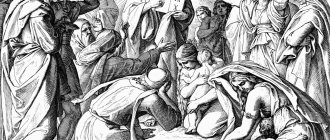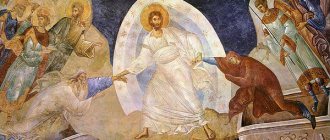Audio version of the article
- What is essence, hypostasis? A.M. Leonov
- “Hypostasis” as a theological term in patristics, Ph.D. A.R. Fokin
- About hypostasis, hypostatic (ενυποστάτον) and non-hypostatic (ανυποστάτον) * About hypostasis * About hypostatic * More about the hypostatic union of St. John of Damascus
- Table. Essence and hypostasis
***
Hypostasis - (from the Greek ὑπόστασις hypostasis hypostasis) - 1) a theological term denoting a specific person (personality), individual, object in which the essence is realized in a real and concrete way; 2) basis, fulfillment (Heb. 11:1).
In the New Testament the word “hypostasis” is used 5 times, exclusively in the epistles of St. Pavel. In 2 Cor. this word is used in an auxiliary sense: “... so that when the Macedonians come with me and find you unprepared, we - I do not say “you” - will not remain in shame, having boasted with such confidence (ἐν τῇ ὑποστάσει ταύτῃ)” (2 Cor 9: 4); “What I say, I will say not in the Lord, but as if in foolishness with such courage (ἐν ταύτῃ τῇ ὑποστάσει) for praise” (2 Cor. 11:17).
The word “hypostasis” is used three times in the Epistle to the Hebrews. In one case it is used without any special semantic load: “For we have become partakers of Christ, if only we hold fast the life we have begun (τὴν ἀρχὴν τῆς ὑποστάσεως)” (Heb. 3:14). Elsewhere in the Epistle the word is used to define the concept of faith: “Now faith is the substance (ὑπόστασις) of things hoped for, and the evidence of things not seen” (Heb. 11:1). The same word is used to characterize the relationship between the Father and the Son: “He is the brightness of His glory and the image of His hypostasis” (Heb. 1:3). This is the only place in the synodal text of St. Scriptures, in which the word “hypostasis” is left without translation; A large number of patristic interpretations are devoted to it, developing in the context of the doctrine of the Holy Trinity.
The concept of “hypostasis” in everyday language simply meant existence. Getting into philosophy, it began to take on the meaning of individual existence. The meaning of this concept was transformed by the Orthodox theology of the Great Cappadocians: St. Basil the Great, St. Gregory the Theologian and St. Gregory of Nyssa.
First of all, the Great Cappadocians consistently distinguished the meaning of the concepts of “essence” (nature, nature) and “hypostasis”. Following their understanding, the difference between essence and hypostasis is the difference between the general and the special (particular).
“In the Holy Trinity, some things are general, and others are special: the general is attributed to the essence, and hypostasis means the peculiarity of each Person,” teaches St. Basil the Great. “First,” says St. Gregory the Theologian, means the nature of the Divine, and the latter means the personal properties of the Three.” St. Gregory of Nyssa explained that the three Hypostases refer to the distinct in God, and God is the name of a single and indistinguishable essence.
Having identified Person and Hypostasis, the Great Cappadocians introduced a new concept - “personality”, which the pagan world did not know. Following their thought, personality is not part of essence or nature, cannot be reduced to natural being, and is not thought of in natural categories.
Divine Persons, according to the disciple of the Great Cappadocians, St. Amphilochia of Iconium is the way of being of the Divine nature. This means that the one God of Christianity is not the impersonal essence of philosophical speculation, is not an abstraction devoid of a living personal relationship to man. He has a specific Personal (Hypostatic) existence, His nature exists personally, it is a living personal being. Moreover, the personal existence of God, who created the world, exceeds human reason. The human mind is created, and God, who created it, infinitely surpasses created nature, revealing himself to man in the incomprehensible unity of the indivisible Divine Persons of the Trinity, which is the Beginning of everything, the Creator of the world.
The Hypostasis of the God-man Jesus Christ in Orthodoxy is recognized as the Hypostasis of the Son of God, the Uncreated Divine Logos. The Hypostasis of Jesus Christ is appended to the title “united and complex.”
***
Use of the term in Scripture
In the canonical books of the Septuagint, the word “hypostasis” appears 19 times. It also occurs once in the Deuterocanonical book of the Wisdom of Solomon and twice in the apocryphal book of the Psalms of Solomon. Through the word υποστασις the Septuagint conveys in various contexts the meanings of 13 different Hebrew words that do not have a clear philosophical meaning.
In the New Testament the word υποστασις is used five times.
In his second letter to the Corinthians, the apostle Paul uses it twice in the usual non-philosophical sense. This word is used in a similar way in the third chapter of the Epistle to the Hebrews. In addition, the word υποστασις is used by the author of the letter to the Hebrews when defining the concept of faith: “Now faith is the substance (υποστασις) of things hoped for, and the evidence of things not seen” (Heb. 11:1). Here this word already acquires a noticeable philosophical content.
The author of the Epistle to the Hebrews chooses the same word to characterize the relationship between the Father and the Son: “This being the radiance of glory and the image of His hypostasis” (Heb. 1:3). This is the only place in the Synodal text of the Holy Scriptures in which the word “hypostasis” is left without translation. The Holy Fathers in their theological works paid special attention to the consideration of this verse. It was on this verse that they relied heavily, giving the word υποστασις the status of one of the main theological terms.
Words with similar meaning
Among them are the following:
- face;
- essence;
- substance;
- quality;
- base;
- function;
- appearance;
- nature;
- first principle;
- nature;
- origin;
- quintessence;
- image;
- attribute;
- kit;
- belonging;
- role;
- view;
- image;
- role;
- mission;
- appointment;
- range of duties;
- reflection;
- expression;
- embodiment;
- form;
- class;
- side;
- edge.
To conclude our study of the issue of hypostasis, it is worth saying a few words about the debate among church representatives around this concept.
Philosophical and theological use of the term
It should be noted that until the century in pagan philosophy, as well as in Christian theology, the terms hypostasis and essence were used as synonyms. So Blessed Theodoret of Cyrus, answering the question: “Is there any difference between essence and hypostasis?” states: “According to external wisdom, no. After all, essence means being, and hypostasis means existence.” In “History of the Church,” Blessed Theodoret cites the words of the Council of Sardicia in 343: “One Hypostasis... of the Father and the Son and the Holy Spirit.” And Blessed Jerome wrote in the 70s of the 4th century: “The school of secular sciences... does not know any other meaning of the word hypostasis than essence” [2].
The first to distinguish “essence” as “being in general” from “hypostasis”, as “definite being”, was Plotinus, and the Neoplatonists even distinguished between these terms, however, “on what this distinction was based and what they believed the difference between the terms to be: unknown "[3].
“For Aristotle, it (the term hypostasis) meant what truly exists, as opposed to concepts and ideas, and was often used as a synonym for the word “nature.” Moreover, it was understood as equivalent to the Latin sub-stantia. In it, more definitely than in the term “nature,” individual existence was assumed” [4].
In the 4th century, at the height of the Trinitarian disputes, through the works of the Great Cappadocians, the term υποστασις acquired an independent meaning, different from the meaning of the term “essence”. This happened due to the convergence of the concepts of hypostasis and face. Thus, St. Basil the Great, in his 210th letter “To the Neo-Caesarean Scholars,” writes: “It is not enough to list the differences of Persons, but one must confess that each Person exists in a true hypostasis.”
Clarifying the trinitarian terminology, the Great Cappadocians first of all distinguished the concepts of essence and hypostasis as general and particular. In the 38th letter of St. Basil the Great “To Brother Gregory” he writes: “So, “hypostasis” is not an indefinite concept of essence, which does not stop at anything in terms of the community of what is signified, but a concept that depicts and outlines in what way by visible distinctive properties - the subject is general and indefinite” [5].
HYPOSTASIS
The widespread use of the concept of “hypostasis” in Christology was preceded by the formation of church teaching about Christ as a single and integral being (for more details, see Art. Jesus Christ). Particular credit for the detailed development of this teaching in the context of polemics with Nestorius and his associates belongs to St. Kirill, bishop Alexandrian. In accordance with his reasoning, the incarnate Word is, first of all, an indivisible integral living being (ἓν ζῷον - Сyr. Alex. Ep. 46. 2 [=Ad Succensum II]). It consists of divinity and humanity, which in Christ are not separated, but only differ “in speculation alone” (θεωρίᾳ μόνῃ - Idem. Quod unus. 736). Although divinity and humanity in Christ and after the union remain for St. Kirill with unchangeable realities, these are not two realities, but one. This one reality of the incarnate Word is described using the formula “one incarnate nature of God the Word” (μία φύσις τοῦ Θεοῦ Λόγου σεσαρκωμένη - Cyr. Alex. (Ps.). Liber de sacrosancta Trinitate. 19 // PG. Vol. 77. Col. 1160 ); in the writings of St. Cyril there is another similar formula: “the one nature of the incarnate Son” (μία φύσις Υἱοῦ σεσαρκωμένου - Idem. Quod unus. 737). At the same time, St. Kirill used the word “hypostasis” in a similar context (see: Cyr. Alex. Ep. 3 ad Nestorium // ASO. T. 1. Vol. 1 (1). P. 38. 22; Idem. Adv. Nest. 2. 8 // ASO. T. 1. Vol. 1 (6). P. 46. 29), apparently understanding the “single nature” precisely as a “single hypostasis”, i.e. as an independently existing unity of the living Christ.
The understanding of the “single nature” as a “single hypostasis” was characteristic of the majority of Orthodox Christians. followers of St. Cyril, who developed his Christological teaching during the period of Monophysite disputes. Yes, St. Proclus, Archbishop K-polsky, explaining in the “Tomos to the Armenians” the Christological ideas of St. Cyril, wrote: “I confess the one Hypostasis of the incarnate God of the Word” ν - ACO. T. 4. Vol. 2. P. 191). It is St. Proclus was the first to strictly contrast the concepts of “nature” and “hypostasis” in a Christological context: “There is one and only begotten Son and Word of God, Who is not divided by His [two] natures into two hypostases, but in Whom, by ineffable Providence, two natures are united into one Hypostasis" (Proclus CP. De dogm. Incarn. // PG. 65. Col. 885; cf.: Ibid. Col. 842-843; Hammerstaedt. 1994. Sp. 1031).
Christological formulas of St. Cyril were reflected in the actions of the Council of Constantinople in 448, which played an important role in the formation of the Orthodox Church. Christological teaching. At this Council of St. Flavian, archbishop. K-polsky, proposed the formulation “one Christ from two natures in one Hypostasis” and thereby connected the unity of Christ with the unity of His Hypostasis: “We recognize that Christ is from two natures (ἐκ δύο φύσεων) after the incarnation, confessing one Christ, one Son and one Lord in one Hypostasis and one Person” (ACO. T. 2. Vol. 1 (1). P. 114). At the same time, St. Flavian recognized as Orthodox and sanctified by the authority of St. Cyril the expression “one incarnate nature of God the Word”: “We also do not refuse to talk about one incarnate and incarnate nature of God the Word” (Ibid. P. 35). However, later most interpreters of St. Cyril preferred to replace the word “nature” with the word “hypostasis” in his formula. Thus, John of Caesarea (Grammarian) clearly considered the “one incarnate nature of God the Word” as a hypostasis, speaking of “the one incarnate Hypostasis of God the Word” (μία ὑπόστασις τοῦ θεοῦ λόγου σεσαρκωμένη - Ioan. Caes. Apol. Consil. Chalced. 5). Later St. Photius, Patriarch of K-Poland, recorded this interpretation of the key formula of St. Cyril as generally accepted: “We think of the single incarnate nature of God the Word as a single Hypostasis” (Phot. Bibl. 229).
Based on the theology of St. Cyril of Alexandria in the interpretation of St. Proclus and St. Flavian, the K-Polish Council of 448, as well as the “Tomos” of St. Leo I the Great, bishop. Roman, directed to St. Flavian, at the IV Ecumenical Council new Christological formulations were developed, the task of which was to better clarify the sacrament of the Incarnation. The idea of the unity of Christ was expressed in them using the term “hypostasis”: “Following the holy fathers, we all teach in agreement to confess one and the same (ἕνα κα τὸν αὐτόν) Son, our Lord Jesus Christ... in two natures unfused, unchangeable, indivisible, inseparable cognizable όμενον), so that the union does not at all abolish the difference of natures ὴν ἕνωσιν), but rather the property (ἰδιότητος) of each nature is preserved and they are united into one Person and one Hypostasis "(ACO. T. 2. Vol. 1 (2). P. 129-130).
The term “hypostasis” in the definition of the IV Ecumenical Council finally received a meaning completely different from the meaning of the term “nature”. In accordance with the theology of the Fathers of the Council, the term “nature” was supposed to demonstrate the reality of the existence of divinity and humanity in Christ, which, as a result of the union, did not undergo changes either in essence or in properties. However, deity and humanity did not remain separate realities, but became a single reality, described by the term “hypostasis.” Divinity and humanity after the Incarnation remained unchangeable realities in Christ, while the division between them can only be imagined. To denote the difference between divinity and humanity in Christ, the conciliar definition uses the word “knowable” (γνωριζόμενον), which is similar to the expression of St. Kirill “speculatively” (θεωρίᾳ).
The single reality of divinity and humanity in Christ is ensured by such a method of their union, which in the patristic tradition is usually called “hypostatic” or union “according to hypostasis” (καθ᾿ ὑπόστασιν). This expression was key in the Christological language of St. Kirill (see, for example: Cyr. Alex. Adv. Nest. II 6 // ACO. T. 1. Vol. 1 (6). P. 42). Unity “according to hypostasis” meant for him the closest possible union, in which, however, deity and humanity do not lose their properties; it is a real and concrete connection. St. spoke about hypostatic union in this sense. Fathers and before St. Kirill. Yes, sschmch. Irenaeus of Lyon wrote about “natural unity according to hypostasis” (Iren. Fragm. Gr. 26). St. Athanasius, bishop Alexandrian, taught about “the union of God the Word with the flesh according to hypostasis” (Athanas. Alex. In psalm. // PG. 27. Col. 136). St. John of Damascus, explaining what unity is according to I., argued: this is the union of two “things” (πραγμάτων) in one person (Ioan. Damasc. Dialect. 65). “Thing” here should be understood as reality, the opposite of abstraction. Moreover, the result of the connection of two “things”, according to St. John, is also a “thing” (Idem. Fragm. philos. 12). Thus, the connection according to I. means that two natures become one I., which is St. John calls it composite or complex (μία ὑπόστασις σύνθετος - Idem. Contr. Jacob. 24; cf.: Idem. Dialect. 67).
The concept of “complex hypostasis” was fixed in the patristic literature of neo-Chalcedonian theology, where it was contrasted with the idea of the “complex nature” of Christ, which developed in the beginning. VI century Monophysite Sevier, Patriarch of Antioch, and his followers. The expression “complex hypostasis” was attributed to St. Cyril of Alexandria, however, it is found only in the treatise “On the Holy Trinity”, in relation to which the authorship of St. Cyril is disputed by modern times. researchers (see: Fraigneau-Julien B. Un traité anonyme de la Sainte Trinité attribué à saint Cyrille d'Alexandrie // RechSR. 1961. T. 49. N 2. P. 188-211; N 3. P. 386- 405). This work, in particular, speaks of Christ as “a single complex hypostasis, consisting of two natures” κ δύο συντεθειμένην φύσεων - Cyr. Alex. (Ps.). Liber de sacrosancta Trinitate. 18 // PG. 77. Col. 1157; compare: Idem. 22 // Ibid. Col. 1161; Idem. 27 // Ibid. Col. 1172). Afterwards This expression was used by the imp. St. Justinian I, who was the inspirer of neo-Chalcedonian theology. Rejecting the Monophysite concept of a complex nature, he offered it instead the idea of a complex I.: “If some say that since they speak of Christ as a single complex Hypostasis, then one should also speak of a single complex nature ... this is alien to piety” (Iustinianus. Edictum rectae fidei // Drei dogmatische Schriften Iustinians. Mil., 1973. P. 144). The expression “complex hypostasis” is found in the 7th century. in the works of diphysite-oriented adherents of monoenergism and monothelitism, who also proceeded from the principles of the neo-Chalcedonian tradition (see: Uthemann K.-H. Der Neuchalkedonismus als Vorbereitung des Monotheletismus: Ein Beitrag zum eigentlichen Anliegen des Neuchalkedonismus // StPatr. 1997. Vol. 29. P . 373-413); in particular, in the unification agreement between the Melkites and the Severians, signed in Alexandria in 633 (see: ACO II. T. 2. Vol. 2. P. 598), as well as in the letter of Sergius, Patriarch of K-Polish, Cyrus , Patriarch of Alexandria, initiator of the Union of Alexandria in 633 (see: Ibid. T. 1. P. 138).
The concept of a “complex hypostasis” was further conceptualized in the Christological constructions of another representative of the neo-Chalcedonian tradition, St. Maximus the Confessor, who often used this concept in his reasoning (see, for example: Maximus Conf. Ep. 12 // PG. 91. Col. 489-493; Idem. Ep. 13 // Ibid. Col. 517 , 525-529; Idem. Ep. 15 // Ibid. Col. 553, 556; Idem. Ambigua 2. 21-22; Idem. Opusc. 2, 3, 7, 13, 16; Idem. Quaest. ad Thalas. 62, 89). On the one hand, Rev. Maxim connects the “complex hypostasis” with the idea of the one whole Christ. The composite nature of the Hypostasis of Christ for him is due to the fact that Christ was entirely God and entirely man. On the other hand, he goes a little further and claims that divinity and humanity were so closely united in the single complex Hypostasis of Christ that He, being “One of the Holy Trinity,” also became “one of us”: “According to the Fathers, [Christ ] there is a single complex Hypostasis in which He, thanks to His divinity, is fully God and One of the Persons of the Holy All-Glorious Trinity with the addition of humanity, and thanks to His humanity He is fully man and one of us with the addition of divinity” (Maximus Conf. Ep. 13 // PG. 91. Col. 525). With letters In understanding, this place means that Christ is one of the human race, just as He is one of the Holy Trinity. The expression “One of the Holy Trinity” was actively used by participants in theopaschist disputes during the reign of St. Justinian (see Art. Theopaschism). Along with the expression “one of the Holy Trinity,” the expression “one Person (persona) of the Holy Trinity” was introduced to clarify that it is not so much about the divine nature of Christ as about His Divine Hypostasis. Therefore, the expression “one of us” in the above statement of St. The maxim can be understood as a reference to the human hypostasis of Christ.
However, consideration of this passage in the broad context of the theological views of St. Maxim allows us to conclude that he did not think that during the incarnation the Hypostasis of God the Word united with the Hypostasis of man, forming a Hypostasis consisting of two I. St. Maxim also did not believe that the Hypostasis of Christ was “supplemented” by a certain human part and became consisting of two parts, but he was convinced that it remained one and the same Hypostasis of God the Word. This follows, for example, from his words: “We say that one Hypostasis of Christ, consisting of flesh and divinity through a natural union, that is, through a true and genuine union, became through this inexpressible union a common Hypostasis for flesh and divinity. I say “common” because one and the same Hypostasis arose from the union; or, it would be better to say, she is, both now and before, one and the same Hypostasis of the Word. However, earlier it existed without cause and was simple and uncomplicated, and later causally it became truly composite without change, having received flesh having a rational soul” (Idem. 15 // Ibid. Col. 556). Thus, Rev. Maxim taught that the Hypostasis of Christ, both before and after the Incarnation, remains the same without k.-l. changes: in itself it does not undergo any change, but after incarnation it also becomes a Hypostasis for the human nature it perceives (for more information about the teaching of St. Maximus about I. see: Grumel. 1926; Madden. 1993; Larchet. 1996. P. 327 -332).
In the same sense I understood the expression “complex hypostasis” and etc. John of Damascus, who paid special attention to him in a number of works. Like his predecessors, he used the concept of “complex hypostasis” to characterize the unity of Christ: “One Christ is a complex hypostasis” (Ioan. Damasc. Contr. Jacob. 74); “... two natures are preserved even after union in one complex Hypostasis (ἐν τῇ μιᾷ συνθέτῳ ὑποστάσει), that is, in one Christ” (Idem. De fide orth. III 5). Thus, Christ is a complex Hypostasis, since he consists of two natures. Moreover, the nature perceived by Him does not have its own independent existence, that is, its own hypostasis, but exists exclusively in the Hypostasis of the Logos: “One complex Hypostasis arose from two natures. Being a Hypostasis with its own essence (ὑπόστασις ἐνούσιος), He received the firstfruits of our mixture - the hypostatic nature (φύσιν ἐνυπόστατον). Moreover, we call it hypostatic not because it exists in itself, and not because it had its own hypostasis, but because it existed in the Hypostasis of the Word” (Idem. Contr. Jacob. 79). St. John presented this idea in a slightly different formulation: The hypostasis is called complex because in two natures Christ is identical both to the two Persons of the Holy Trinity and to us: “Christ, being a complex hypostasis, is by nature identical with the Father and the Spirit, and also with the Mother and us "(Ibid. 74).
St. John opposed considering the “complex hypostasis” of Christ as consisting of two hypostases or containing elements of the human hypostasis: “It is absolutely impossible that [in Christ there was] one complex nature consisting of two natures, or one hypostasis consisting of two hypostases" (Idem. Dialect. 67). The single complex Hypostasis of Christ is actually the Hypostasis of the Logos, but it is also a Hypostasis for humanity: “We are talking about the same Hypostasis of His deity and humanity” (Idem. De fide orth. III 3). Even more expressively St. John formulated this idea in his treatise “On Complex Nature,” directed against the acephalous heresy: “Both the deity and humanity of Christ are hypostatic (ἐνυπόστατος), because each [nature] has [as a hypostasis] His common complex Hypostasis. Moreover, the deity [has it] is pre-eternal and eternal, and rational and animate flesh was perceived by it, exists in it and has [it as] the same Hypostasis” (Idem. Contr. aceph. 6).
Human nature is the element that makes the Hypostasis complex - in the words of St. John, “replenishes” the Hypostasis of Christ: “the hypostatic nature that completes the complex Hypostasis of Christ” ς - Idem. Contr. Jacob. 53). This does not mean that without the flesh the Hypostasis would be incomplete, however, without the perceived flesh the Hypostasis would remain simple: “The Hypostasis, initially being simple, later became complex ... thanks to the deity preexisting in it and the flesh subsequently perceived” (Idem. Contr. Nest. 2 ). Christ received from the Virgin “not hypostasis, but hypostatic flesh” (σάρκα ἐνυπόστατον, οὐχ ὑπόστασιν), which in Him received its hypostasis, that is, it acquired real, concrete existence. Therefore, the Hypostasis of Christ was at first simple, and then became complex (Ibidem).
Not all are Orthodox. the authors of the era of Christological disputes unconditionally accepted the concept of complex I. In particular, Leontius of Jerusalem saw in it a type of Nestorianism, if we understand it in the sense that the Hypostasis of Christ comes from two I. - human and Divine (Leont. Hieros. Contr. Nestor. / / PG. 86. Col. 1485). At the same time, he was ready to agree with the doctrine of complex I., if we recognize that it is composed not of two I., but of two natures: “If you claim that a complex hypostasis is made of two natures, we will agree; but if it is, as it were, from [two] hypostases, let it not be!” (Ibid. Col. 1585). As an alternative to the doctrine of complex I. Leonty proposed using the concept of natures connected according to I. (for more details, see: Gray. 1986). Leontius of Jerusalem, like Leontius of Byzantium, was not a supporter of neo-Chalcedonism, within the framework of which the concept of “complex hypostasis” arose. They proposed a slightly different way of explaining the unity of Christ, introducing the concept of “hypostatic” into Christological usage: “Hypostasis and the hypostatic (ἐνυπόστατον) are not the same thing, just as essence and essential (ἐνούσιον) are different. For hypostasis means someone specific, and hypostatic means essence. And the hypostasis determines the person (πρόσωπον) by distinctive features, and the hypostatic indicates that it is not an incidental property that has existence in another and is not contemplated in itself” (Leont. Byz. Contr. Nestor. et Eutych. // PG 86. Col. 1277-1280; for more details, see article Voipostasnoe).
Definition of the term
There is a certain difficulty in differentiating the term “hypostasis”. So the Holy Fathers wrote:
St. Basil the Great:
“The concept of the general refers to the essence, and hypostasis is
the distinctive feature
of each (Person)” [6];
“So the unborn is a way of being
, not the name of the entity” [7];
St. Amphilochius of Iconium:
“After all, Father, Son and Holy Spirit are the names of a way of existence, that is, a relationship
«;
St. John of Damascus:
“(Hypostasis) means that which exists in itself
, on one's own";
Abba Thalassius of Libya:
“Hypostasis defines a nature with personal properties
; so that each hypostasis has both that which is common to nature and that which is proper to the hypostasis” [8];
Archimandrite Cyprian (Kern) testifies: “For both Gregori (Gregory of Nyssa and Gregory the Theologian) the Hypostasis is not only a separate individual with its own distinctive features, but also a really existing rational person. Hypostases are thus ways of Divine existence
» [9];
Father Oleg Davydenkov: “Hypostasis indicates not only the difference
, but also on
the self-identity
of a thing, its numerical difference, that is, on
a separate existence
” [10];
V.N. Lossky spoke about the irreducibility of hypostasis to essence: “Hypostasis is that which is ousia.”
(essence), all the properties are applicable to it - or all the negations - which can only be formulated in relation to the “super-essence”, and,
however, it remains irreducible to us
. This irreducibility can neither be grasped nor expressed outside the relationship of the three Hypostases, which, strictly speaking, are not three, but “Three-Unity” [11]. And this difference can be expressed by the fact that nature answers the question “what,” while hypostasis answers the question “who,” which is answered only with a proper name.
The one God of Christianity is not the impersonal essence of philosophical speculation, nor is it an abstraction devoid of a living personal relationship to man. He has a specific Personal (Hypostatic) existence, His nature exists personally, it is a living personal being. Moreover, the personal existence of God, who created the world, exceeds human reason. The human mind is created, and God, who created it, infinitely surpasses created nature, revealing himself to man in the incomprehensible unity of the indivisible Divine Persons of the Trinity, which is the Beginning of everything, the Creator of the world.
Etymology
Etymological scientists were able to trace the origin of the object being studied back to the Proto-Indo-European language. There is a stem sta, meaning “to stand, to put.” Further in ancient Greek we find the verb ἵστημι, which is translated as “to arrange, place, stand, erect.”
From it the noun στάσις was formed meaning “arrangement, establishment.” Then the prefix ὑπό was added to it, meaning “under, below,” and the ancient Greek word ὑπόστασις was obtained, which is interpreted as “maintenance, existence, personality, essence.”
Next, synonyms for the word “hypostasis” will be given.
Greek philosophy
The term "hypostasis" was used by the Stoics when they explained the existence of individual things. Thus, when Chrysippus said that the original matter, which has no qualities, turns into elements, then it becomes objectified. More specifically, it is “hypostatized.”
This word can also be found among the Peripatetics. What did the term “hypostasis” mean to them? It is synonymous with Aristotle's "original essence." That is, a certain basis, and not its specific manifestations.
The Neoplatonists, in particular Porphyry, called two types of substances this way. Some hypostases, “perfect” ones, represented certain divine essences. They arise in the process of emanation (outpouring) of the Single Origin. Other hypostases - imperfect, base - are the totality of all the objects of our existence. Thus, the views of the Neoplatonists in this regard were a mixture of the theories of the Stoics and the Peripatetics. Plotinus called this the Good, Reason and Soul.
Further theological debate about the Trinity
These discussions continued into the fifth to seventh centuries. In this era, for the establishment of orthodoxy, it was necessary to officially interpret such a complex concept as the Theanthropic essence of Christ. Hypostasis is precisely the philosophical term that has greatly helped theologians in resolving this problem.
Theologians Maximus the Confessor, Leontius of Byzantium and some others proposed a theory according to which two natures were united in Christ. Thus, He represented a complex hypostasis. This term was also used to interpret the trinity. This is mainly characteristic of Greek patristics.
The remaining Persons of the Trinity were also understood as hypostases of the divine trinity. They were likened to the root, fruit and trunk of a tree.
Literature[ | ]
- Hypostasis // Encyclopedic Dictionary of Brockhaus and Efron: in 86 volumes (82 volumes and 4 additional). - St. Petersburg, 1894. - T. XIII. — P. 294.
- Kartashev A.V. Ecumenical Councils
- Paris, 1963 - Lossky V.N.
Dogmatic theology - M., 1991 - Prot. John Meyendorff. "Jesus Christ in Eastern Orthodox Theology". - M., 2000.
- St.
John of Damascus. Source of knowledge Transl. from Greek and comment. D. E. Afinogenova, A. A. Bronzova, A. I. Sagardy, N. I. Sagardy. - M.: Indrik, 2002. - 416 p. — (Patristic Heritage. Vol. 5) - Lurie V. M.
History of Byzantine philosophy.
Formative period. - St. Petersburg, Axioma, 2006. XX + 553 p. ISBN 5-90141-013-0 Table of Contents, Section 1, Ch. 1, Section 1, Ch. 2, Section 2, Ch. 1, Section 2, Ch. 2, Section 4, Ch. 1, Section 4, Ch. 2[ unauthoritative source?
] - Kirill (Govorun), archim., Fokin A. R.
Hypostasis // Orthodox Encyclopedia. - M., 2011. - T. XXVI: “Joseph I Galisiot - Isaac the Syrian.” — P. 180-193. — 752 p. — 39,000 copies. — ISBN 978-5-89572-048-6.
Notes[ | ]
- Ancient Greek-Russian dictionary [in 2 vols.]: Ok. 70,000 words (in both volumes) / Compiled by I. Kh. Dvoretsky; Ed. member-corr. Academician Sciences of the USSR S.I. Sobolevsky. With the application of a grammar compiled by S. I. Sobolevsky. - M.: GIS, 1958
- Hypostasis (inaccessible link) // Krysin L.P. Explanatory dictionary of foreign words. - M.: Eksmo, 2008. - 944 p. — (Library of dictionaries).
- ↑ 1 2
What does the word “hypostasis” mean in Orthodoxy?
(Russian) (undefined)
.
Shrines
. - Athanasius the Great.
Message to the African Bishops (Russian).
ABC of Faith
. - Aristotle, Categories, ch. 5
- History of the doctrine of the Holy Trinity in the 4th century. VII. The Cappadocians and their theology. // Spassky A. A. “History of dogmatic movements in the era of the Ecumenical Councils.” - pp. 489-490
- ↑ 1 2 3 4 5 6 7 8 9 10 11 12 13 14 15 Lurie V. M.
History of Byzantine philosophy. Formative period. - St. Petersburg, Axioma, 2006. XX + 553 p. ISBN 5-90141-013-0 Table of Contents, Section 2, Ch. 1 - Kartashev A.V.
Ecumenical Councils.
- Klin, 2004. - pp. 140-141 - Vasily Vasilievich Bolotov.
History of the Church during the period of the Ecumenical Councils The First Ecumenical Council // Lectures on the history of the Ancient Church. - Mikhail Emmanuilovich Posnov.
“New Nicenes”, Cappadocians // History of the Christian Church. - Character (ancient Greek χαρακτήρ) is a hypostatic idiom (when there is only one, as in the hypostases of the Trinity) or a set of such idioms (in created hypostases there are usually many hypostatic idioms).
- Idiom (ancient Greek ἰδιώμα), or feature (hypostatic) is what distinguishes one hypostasis of a given essence from another hypostasis of the same essence. It should not be confused with the idiom of essence (distinguishing one essence from another) and with random (accidental) signs that can easily change in the same hypostasis (but in God there can be nothing accidental, so such signs are possible only in created hypostases ). The definitions of “idiom” and “accidental” (accidental, lat. accidentia, accident) go back to Porphyry’s “Isagoge”
- see the author’s (Basily the Great) summary of these ideas in the treatise “Against Eunomius” in “Epistle 236 (228)”, from which the definition of “hypostasis” was already quoted above
- Priest Oleg Davydenkov Dogmatic theology The doctrine of the Holy Trinity of the great Cappadocians. Trinity terminology
- That is, it has two natures (Divine and human), but one hypostasis (Divine)
(Church Glorious) - The Mother of God Dogmatist of the Eighth Tone (undefined)
(inaccessible link). Retrieved March 1, 2007. Archived February 20, 2007.











